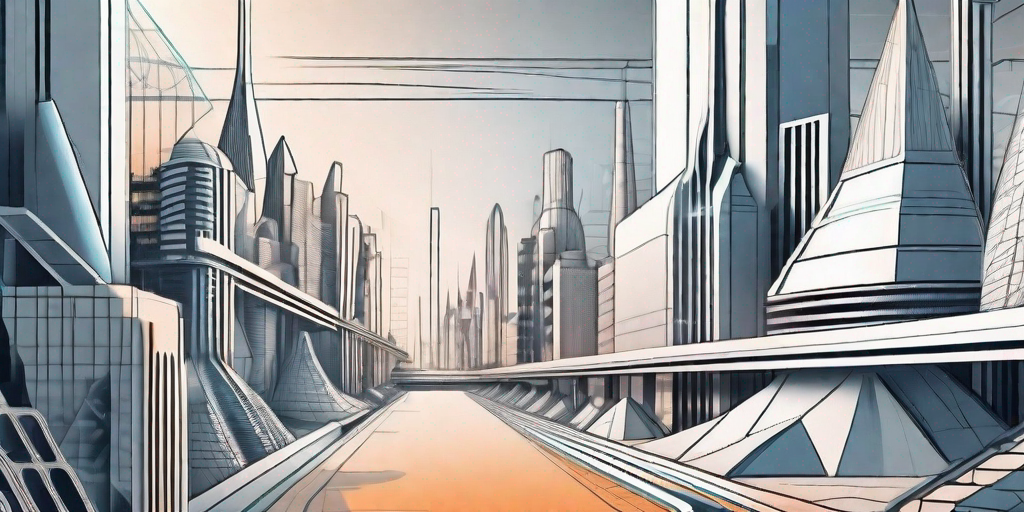Strategy Futurist's Guide to Understanding 3D Printing

Strategy Futurist's Guide to Understanding 3D Printing
In today's rapidly evolving technological landscape, keeping abreast of the latest trends and innovations is crucial for individuals and businesses alike. One such innovation that has been making waves in recent years is 3D printing. This groundbreaking technology has the potential to revolutionize industries as diverse as healthcare, manufacturing, and even fashion. But understanding the complexities of 3D printing can be daunting, which is why a strategy futurist's insight is invaluable.
Understanding the Complexities of 3D Printing
At its core, 3D printing is a process by which a three-dimensional object is created by adding layer upon layer of material until the desired shape is achieved. This additive manufacturing process offers numerous advantages over traditional manufacturing methods, such as reduced waste and increased design flexibility. However, to fully grasp the intricacies of 3D printing, it is essential to delve deeper into the technology itself.
One key element to understand is the wide array of materials that can be used in 3D printing. From plastics like ABS and PLA to metals like titanium and steel, the possibilities are seemingly endless. Each material possesses its own unique characteristics and properties, which can greatly influence the final product. For example, a part printed in plastic may be lightweight, while one printed in metal can be exceptionally strong.
Moreover, the advancements in material science have led to the development of composite materials that combine the properties of multiple materials. These composites can offer enhanced strength, durability, and even electrical conductivity. For instance, carbon fiber-reinforced plastics are commonly used in aerospace applications due to their high strength-to-weight ratio.
Another crucial aspect of 3D printing is the role of computer-aided design (CAD) software in the process. CAD software allows users to create digital models of objects, which can then be translated into physical objects through 3D printing. This technology empowers designers and engineers to bring their creative visions to life and iterate on designs more quickly and efficiently than ever before.
Furthermore, the integration of CAD software with simulation tools enables engineers to analyze the structural integrity and performance of the 3D printed parts before they are physically manufactured. This virtual testing capability helps in identifying potential design flaws and optimizing the part's performance, leading to cost and time savings in the production process.
Moreover, the printing process itself can vary depending on the specific technology being used. From fused deposition modeling (FDM) to stereolithography (SLA) and selective laser sintering (SLS), each method has its own advantages and limitations. Understanding the different techniques and their applications is crucial for leveraging 3D printing to its fullest potential.
For instance, FDM, which is one of the most widely used 3D printing technologies, works by extruding melted filament layer by layer to build the object. It is suitable for producing prototypes and functional parts with moderate complexity. On the other hand, SLA utilizes a liquid resin that is cured layer by layer using a UV laser, resulting in high-resolution prints with smooth surface finishes. This technology is often preferred for producing intricate and detailed models.
Additionally, SLS employs a laser to selectively fuse powdered material, such as nylon or metal, layer by layer. This technique is known for its ability to produce strong and durable parts with complex geometries, making it suitable for various industrial applications.
In conclusion, 3D printing is a fascinating technology that offers a wide range of possibilities in manufacturing. By understanding the different materials, CAD software, and printing techniques involved, one can fully appreciate the complexities and potential of this revolutionary process.
The Role of a Strategy Futurist in Deciphering 3D Printing Trends
With the rapid pace at which technology evolves, it can be challenging to identify which emerging trends will truly have a lasting impact. This is where a strategy futurist comes in. Drawing from their expertise in technology, business strategy, and industry insights, a strategy futurist can provide invaluable guidance in navigating the complex world of 3D printing.
By closely monitoring developments in the field and analyzing market dynamics, a strategy futurist can help identify key opportunities and potential pitfalls. They can offer a strategic perspective on how 3D printing can be integrated into existing business models or even create entirely new revenue streams. Their ability to assess the potential impact of 3D printing on industries can be instrumental in shaping long-term strategies.
Moreover, a strategy futurist can help demystify the hype surrounding 3D printing by providing an objective analysis of its capabilities and limitations. While 3D printing undoubtedly promises a wealth of possibilities, it is essential to understand its current constraints and practical applications. A strategy futurist can offer insights grounded in reality, guiding decision-makers towards informed and calculated decisions.
One area where a strategy futurist can provide valuable insights is in the realm of healthcare. 3D printing has the potential to revolutionize the medical industry by enabling the production of customized medical devices, prosthetics, and even organs. A strategy futurist can help healthcare organizations understand how to leverage this technology to improve patient care, reduce costs, and enhance overall efficiency.
In the automotive industry, 3D printing is already making waves. From prototyping to manufacturing spare parts, this technology has the potential to disrupt traditional supply chains and streamline production processes. A strategy futurist can assist automotive companies in identifying the most impactful use cases and developing strategies to stay ahead of the competition.
Furthermore, the construction industry is also exploring the possibilities of 3D printing. From printing entire houses to creating intricate architectural designs, this technology has the potential to revolutionize the way buildings are constructed. A strategy futurist can help construction companies navigate the complexities of implementing 3D printing, from selecting the right materials to optimizing the printing process for large-scale projects.
Another area where a strategy futurist can provide valuable insights is in the realm of sustainability. 3D printing has the potential to reduce waste and energy consumption by enabling on-demand manufacturing and eliminating the need for traditional mass production. A strategy futurist can help businesses understand how to leverage this technology to create more sustainable and environmentally friendly practices.
As the field of 3D printing continues to evolve, a strategy futurist's role becomes increasingly crucial. Their ability to decipher trends, assess opportunities, and provide strategic guidance can help businesses stay ahead of the curve and capitalize on the transformative potential of this technology. By embracing the expertise of a strategy futurist, organizations can navigate the complex landscape of 3D printing with confidence and unlock new possibilities for growth and innovation.
How 3D Printing is Shaping Future Industries
The influence of 3D printing on various industries is already tangible, and its impact is only poised to grow in the coming years. One sector that has been profoundly shaped by this technology is healthcare. From custom prosthetics to patient-specific implants, 3D printing is revolutionizing the way medical devices are manufactured and improving patient outcomes. The ability to tailor treatments to individual needs is a game-changer in the field of medicine.
In the realm of manufacturing, 3D printing allows for increased efficiency and cost savings. Complex parts can be printed in one go, eliminating the need for assembly and reducing material waste. This not only streamlines the production process but also opens up new design possibilities that were previously unattainable. As a result, companies can bring innovative products to market faster and more economically.
The influence of 3D printing is not limited to traditional industries; it is also making waves in the world of fashion. Designers are harnessing the power of this technology to create avant-garde garments and accessories that push the boundaries of what is possible. From intricate jewelry to customizable shoes, 3D printing is enabling new levels of creativity and personalization in the fashion industry.
Another industry that is being transformed by 3D printing is architecture. With this technology, architects can now create intricate and complex models with ease. They can print scaled-down versions of buildings, allowing clients to visualize the final product before construction begins. This not only enhances communication between architects and clients but also saves time and resources by identifying design flaws early on.
Furthermore, the automotive industry is also benefiting from 3D printing. Car manufacturers can now produce lightweight and durable parts using advanced materials. This not only improves fuel efficiency but also enhances overall vehicle performance. Additionally, 3D printing enables the production of customized car components, allowing for a more personalized driving experience.
3D printing is even making a significant impact in the field of aerospace. The ability to print complex and lightweight parts is revolutionizing aircraft manufacturing. This technology allows for the creation of intricate designs that were previously impossible to produce using traditional manufacturing methods. As a result, aircraft can be made lighter, more fuel-efficient, and safer.
Moreover, the art and design industry is embracing 3D printing as a medium for creative expression. Artists can now bring their digital designs to life by printing them in three dimensions. This opens up a whole new realm of possibilities, allowing for the creation of unique sculptures, installations, and even functional objects.
Lastly, the food industry is also exploring the potential of 3D printing. Chefs and food scientists are experimenting with printing edible creations, ranging from intricate chocolate sculptures to personalized nutritionally balanced meals. This technology has the potential to revolutionize the way food is prepared and consumed, offering new levels of customization and efficiency.
In conclusion, 3D printing is shaping future industries in numerous ways. From healthcare to manufacturing, fashion to architecture, automotive to aerospace, and even art to food, this technology is revolutionizing the way we create, design, and produce. As it continues to evolve and improve, the possibilities for innovation and creativity are endless.
Strategy Futurist's Insight on 3D Printing's Potential
Looking ahead, the potential of 3D printing is nothing short of extraordinary. Its impact will extend far beyond the industries we currently envision. As a strategy futurist, it is my role to help shape this future and guide organizations towards successful implementation and innovation.
By staying attuned to emerging trends and closely monitoring advancements in 3D printing technology, strategy futurists can provide valuable insights on how this transformative technology will continue to reshape industries. Whether it's anticipating breakthrough materials, identifying key markets, or anticipating regulatory changes, a strategy futurist can be a trusted partner in leveraging the potential of 3D printing.
The Future of 3D Printing According to Expert Predictions
So, what does the future hold for 3D printing? Expert predictions vary, but there is a consensus that this technology will continue to evolve and expand its horizons. As advancements in materials and printing techniques continue to emerge, the range of applications will only grow.
Some experts predict that 3D printing could eventually enable on-demand manufacturing, allowing products to be printed on-site rather than transported across the globe. This could revolutionize supply chains, reduce environmental impact, and offer new levels of customization and personalization.
Others believe that bioprinting, the ability to print living tissue and organs, holds incredible promise for healthcare. Imagine a future where patients in need of an organ transplant no longer have to wait for a donor but can instead receive a 3D-printed organ tailored to their unique biology. This field of research is still in its infancy, but the potential is staggering.
While there are undoubtedly challenges and obstacles to overcome, the future of 3D printing appears bright. As a strategy futurist, I am excited to be part of this journey and witness the transformative impact of this technology on industries, society, and our collective imagination.
FAQ
What is 3D printing and how does it work?
3D printing is a process by which a three-dimensional object is created by adding layer upon layer of material until the desired shape is achieved. This additive manufacturing process offers advantages such as reduced waste and increased design flexibility.
What materials can be used in 3D printing?
A wide array of materials can be used in 3D printing, including plastics like ABS and PLA, metals like titanium and steel, and even composite materials that combine the properties of multiple materials. Each material has its own unique characteristics and properties, influencing the final product.
How is 3D printing shaping future industries?
3D printing is already making a significant impact in various industries. It is revolutionizing healthcare by enabling the production of customized medical devices and patient-specific implants. In manufacturing, it allows for increased efficiency and cost savings. In fashion, it enables new levels of creativity and personalization. Additionally, it is transforming industries such as architecture, automotive, aerospace, art, and even food.
Contact a Strategy Futurist for Your Event
Having read about the complexities and potential of 3D printing, you may now be considering how to leverage this transformative technology for your business. Why not bring Dr Mark van Rijmenam, a renowned Strategy Futurist, to your next event? With his deep expertise in 3D printing, Dr van Rijmenam can provide invaluable insights tailored to your industry, helping you navigate the rapidly evolving technological landscape. He can demystify the hype, identify opportunities, and guide your strategic decision-making to unlock new possibilities for growth and innovation. To inquire about Dr van Rijmenam's availability, simply complete the form below. We will be in touch within 24 hours, ready to bring a future-focused perspective to your event.





